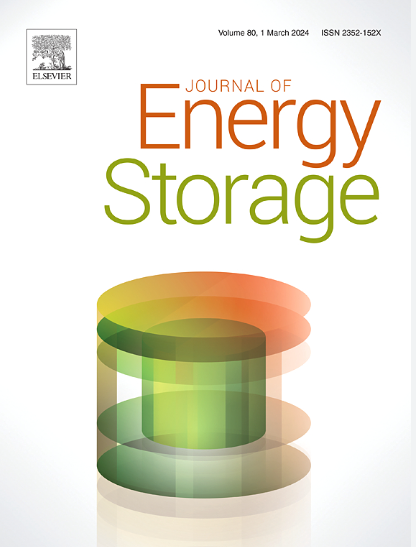基于不同电压段充电时间的锂离子电池健康状态评估方法
IF 8.9
2区 工程技术
Q1 ENERGY & FUELS
引用次数: 0
摘要
锂离子电池健康状态(SOH)的准确估计对电动汽车和储能系统的安全性和可靠性至关重要。然而,实际充电电压范围的可变性和不可预测性限制了许多现有方法的适用性。本研究使用数据驱动方法估算SOH,该方法利用不同电压段的充电持续时间,使其适用于广泛的充电电压范围。采用鲸鱼优化算法-优化径向基函数神经网络(WOA-RBFNN)进行SOH估计。采用增量容量分析(ICA)方法,选择电池老化变化明显的5个电压段,而不是直接从增量容量曲线(ICC)中选择电压段的充电时间或峰谷。通过ICA验证,充电持续时间与ICC的包络面积成正比,使其成为每个电压段的合适健康指标(HI)。然后,利用WOA-RBFNN构建充电时间与SOH之间的映射关系。用两个具有代表性的数据集对该方法进行了验证。结果表明,平均绝对误差小于0.589%,均方根误差小于0.701%。该方法适用于较宽的充电电压范围,提高了其实用性。本文章由计算机程序翻译,如有差异,请以英文原文为准。
A practical state of health estimation method for lithium-ion batteries using charging duration in different voltage segments
Accurate state of health (SOH) estimation for lithium-ion batteries is essential for the safety and reliability of electric vehicles and energy storage system. However, the variability and unpredictability of actual charging voltage ranges limit the applicability of many existing methods. This study estimates SOH using a data-driven method that utilizes the charging duration of different voltage segments, making it applicable to a wide range of charging voltages. The whale optimization algorithm-optimized radial basis function neural network (WOA-RBFNN) is employed for SOH estimation. Five voltage segments with significantly changes due to battery aging are selected based on incremental capacity analysis (ICA), instead of directly selecting the charging duration of the voltage segments or the peaks and valleys from the incremental capacity curve (ICC). It is verified through ICA that the charging duration is proportional to the ICC’ envelope area, making it a suitable health indicator (HI) for each voltage segment. Then, the WOA-RBFNN is employed to construct the mapping between charging duration and SOH. The proposed method is validated using two representative datasets. The results demonstrate that the mean absolute error is below 0.589%, and the root mean square error is below 0.701%. The proposed method is applicable to a wide range of charging voltage, enhancing its practical usability.
求助全文
通过发布文献求助,成功后即可免费获取论文全文。
去求助
来源期刊

Journal of energy storage
Energy-Renewable Energy, Sustainability and the Environment
CiteScore
11.80
自引率
24.50%
发文量
2262
审稿时长
69 days
期刊介绍:
Journal of energy storage focusses on all aspects of energy storage, in particular systems integration, electric grid integration, modelling and analysis, novel energy storage technologies, sizing and management strategies, business models for operation of storage systems and energy storage developments worldwide.
 求助内容:
求助内容: 应助结果提醒方式:
应助结果提醒方式:


